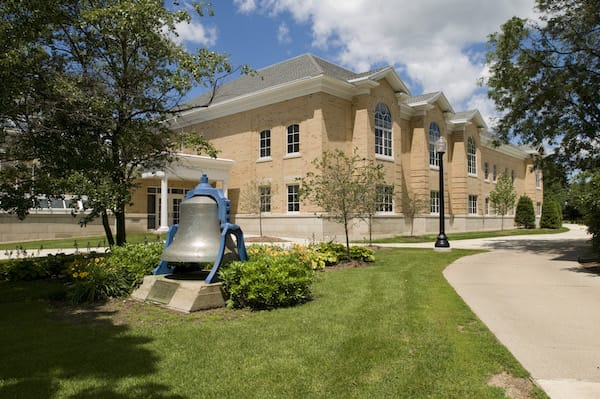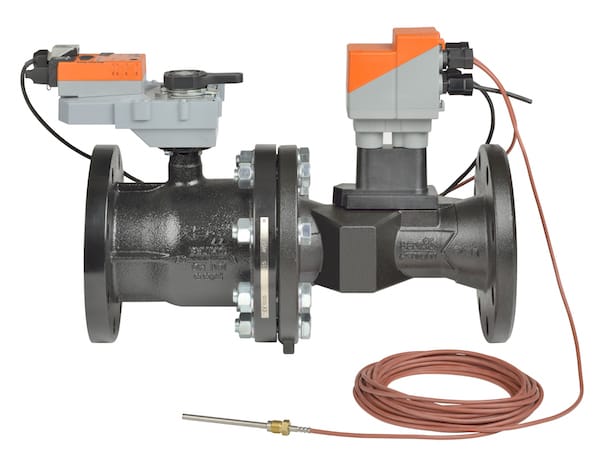Founded in 1844, Hillsdale College, located in Hillsdale, Mich., is known for its strong tradition in liberal arts and classical education. Its campus spans approximately 400 acres and encompasses 51 buildings, including residence halls, classroom buildings, computer labs, science laboratory buildings, a state-of-the-art health education with a sports complex, library, dining facilities, small hotel, and various office buildings. All together, buildings affiliated with the college account for approximately 1.4 million square feet of total space.

In June of 2011, Hillsdale’s Energy Department implemented an energy management program in an effort to reduce the costs associated with providing utility services to the campus. The primary goal of the plan was to help the college absorb potential utility rate hikes while avoiding the need to increase its utility budget as both newly constructed and renovated facilities were completed and became occupied. The first step in the plan involved evaluating campus-wide energy usage from a standpoint of organizational behavior. This required monitoring occupied needs and comparing those needs with system runtimes to see when and where internal efficiency could be gained.
After roughly a year and a half of trying to achieve savings through this method, maintenance personnel, in conjunction with the administration at Hillsdale, concluded that in order for the strategic goals set forth in the energy plan to be met, a more creative and proactive approach would have to be taken. With that in mind, the college’s Energy Department began closely examining the operation of HVAC systems and related mechanical equipment to better identify areas where more substantial savings could be achieved through both system optimization and various infrastructural improvements.
Chilled Water System Overview
The majority of Hillsdale College’s chilled water needs are handled by a main loop, which is driven by a central chilling plant. The plant was commissioned in 1999 and features two chillers (500-ton and a 650-ton) that combine to service over 800,000 square feet of building space. With limited diagnostic capabilities under the current building automation system, technicians at Hillsdale had limited access to data coming out of the central plant. Information such as overall flow in the system measured in total gallons per minute (GPM), entering and returning water temperatures, and pump speed were retrievable; however, technicians did not have the capability to determine if those numbers were representative of occupancy need at individual facilities given what each air handler was calling for with regards to cooling and chilled water. In order to more accurately determine where inefficiencies were present, energy management personnel began looking at the performance of individual air handlers, and more specifically, chilled water Delta T across each of the cooling coils. They then compared those findings with how the equipment was initially designed and commissioned.

Energy Valve features efficient regulation of flow and heat exchanger output and monitoring of Delta T, and dynamic balancing regardless of pressure fluctuations with continuous flow measurement.
Although the size and number of air handling units (AHUs) in buildings vary throughout the campus (generally ranging from one to as many as five), examination of coils revealed a costly issue. In many instances, delta T was recorded between 3– 7°F. Under normal circumstances, a cooling coil is designed to produce a delta T of approximately 10-12°F , which allows for the maximum number of BTUs to be extracted from each gallon of chilled water that flows through the coil. This was below the cooling coils’ intended design specifications, indicating that many of Hillsdale’s buildings were experiencing “low delta T” syndrome.
Typically, low delta T is caused by over flowing chilled water through the cooling coil, which results in inefficient heat transfer. In addition to higher electricity costs due to over pumping, this triggered the second chiller at Hillsdale’s plant to come online in order to handle the volumetric flow requirement of the system. The issue was so severe that the installation of a third chiller was being considered to handle the increased load. Though problematic, this presented Hillsdale with an opportunity to reduce energy consumption by increasing delta T in the coils. Recognizing this, staff in the maintenance department began searching for a solution, which eventually led them to the Belimo Energy Valve.
Customer Requirements: Increase Delta T, Improve Pumping Efficiency, Reduce Energy Usage
- Hillsdale College sought to increase chilled water Delta T across coils to their intended design specifications. In doing so, chilling capacity that was currently being wasted (tonnage) could be recaptured, electricity usage in response to pumping requirements could be decreased, and overall energy consumption would be reduced. Increased pumping efficiency regarding the overall GPM flow in the chill water loop could possibly offset the immediacy of installing a third chiller in the central plant. This was a primary concern due to the fact that additional facilities were being built and renovated throughout the campus. When complete, the new buildings may have pushed the existing chillers past their capacity.
- College maintenance technicians and administrators sought to implement a solution that could increase visibility into the operation of the air handlers in each of the individual buildings, specifically the air handlers’ cooling coils. Under typical building automation systems, real-time access to such data (entering water temperature, leaving water temperature, water volume, etc.) is not available.
- Hillsdale officials wanted to improve occupancy comfort.
In the Spring of 2013, Hillsdale College made the decision to install three Energy Valves as part of a pilot test. Two of the valves were installed in the campus’s 60,800 SF Mossey Library and the third in Delp Hall, a 20,000 SF square foot office building. In addition to determining if the Energy Valve could increase chilled water delta T across the coils and subsequently improve pumping efficiency, the test was used to assess the diagnostic capabilities of the valve. Hillsdale’s maintenance staff also utilized the valve’s data points to determine how easily its platform could be integrated with existing control systems on the campus. The Energy Valves were purchased from Belimo’s Platinum Distributor Cochrane Supply in Madison Heights, Michigan.
Utilizing its built-in Power Control and Belimo Delta T Manager logic that monitor performance and maximize available energy to the coil, the Energy Valves increased delta T in coils to between 10 – 12°F. By correcting the coils’ flow and allowing them to operate at their designed specifications, the valves eliminated any potential over pumping, thereby enhancing cooling efficiency. The college’s maintenance technicians also used the diagnostic capabilities of the Energy Valve to develop a customized control dashboard, which provided visibility into the operation of the cooling coils and real-time access to discharge air temperatures in the air handlers and cumulative data regarding the total number of gallons of chill water being used across the cooling system. Users were able view all of this information from a simple web interface. This data was used to control pumps with variable frequency drives (VFDs), allowing them to ramp down when coils were satisfied, thereby reducing overall chiller load.
After the success of the pilot test, the decision was made to install additional Energy Valves throughout the campus. Over the course of the next year (from May of 2014 to May of 2015), 24 Energy Valves were installed in 11 buildings across the main chilled water loop (sizes from 1/2 to 4-inch). In some coils, delta T’s were seen as high as 30°F while sufficiently maintaining the air handler’s desired discharge air cooling temperature.
Benefits/Results:
- Increased chilled water Delta T across coils to their design of 10 -12°F
- Increased pumping efficiency and reduced energy consumption.
- Recaptured chiller capacity and reduced the need for a third chiller in the central plant. Usage of the second chiller was also decreased by roughly 300 hours during that year’s cooling cycle.
- Used feedback data from Energy Valve to control pumps with variable frequency drives (VFDs), allowing for more precise control of the chilled water loop without sacrificing the AHUs call for cooling during occupied times.
- Diagnostic capabilities allowed for visibility into individual building’s and cooling coil performance, which helped make projections regarding future energy consumption.
- Hillsdale College was able to develop a central control dashboard that allowed data to be viewed from all Energy Valves on one page. This enabled maintenance technicians to monitor and react quickly to variables and to diagnose problems that impact both occupant comfort and energy savings.




Join the conversation: